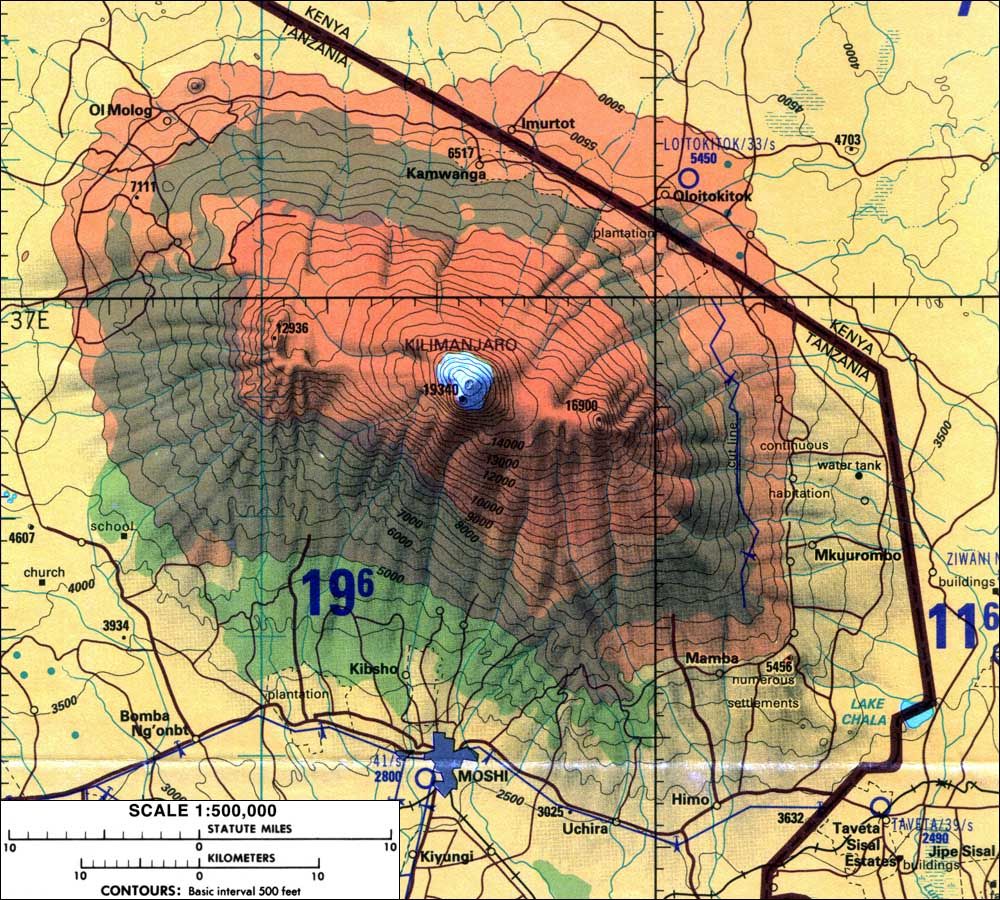MOUNT KILIMANJARO
The Complete Guide
The Complete Guide to Climbing Mount Kilimanjaro
Mount Kilimanjaro, standing tall in Tanzania, East Africa, is an awe-inspiring geographical marvel and a beacon for adventurers worldwide. As the highest freestanding mountain globally, this dormant stratovolcano graces the African landscape, reaching an impressive elevation of approximately 5,895 meters (19,341 feet) above sea level. Its majestic presence and diverse climate zones, ranging from lush rainforests to an icy summit, make it a magnet for trekkers, climbers, and nature enthusiasts. Kilimanjaro embodies not only a challenging ascent but also a journey through various ecosystems, offering a glimpse into the continent’s rich biodiversity and a taste of the spiritual and cultural significance it holds for the local Chagga people.

Geographical Location and Elevation
Mount Kilimanjaro is situated in the northeastern part of Tanzania, near the border with Kenya. Specifically, it is located in the Kilimanjaro Region, within Kilimanjaro National Park. The mountain stands as a significant landmark in the Eastern Rift Mountains, a prominent mountain range that extends from the Red Sea through Eastern Africa. Its coordinates are approximately Latitude 3.0759° S and Longitude 37.3530° E, making it easily identifiable on the African continent due to its towering height and distinct shape.
In terms of elevation, Kilimanjaro’s highest peak, known as Uhuru Peak, is a part of the Kibo cone. Uhuru Peak rises to an impressive elevation of approximately 5,895 meters (19,341 feet) above sea level. This summit is characterized by glaciers and a permanent ice cap, although sadly, these features are diminishing due to the adverse impacts of climate change. Kilimanjaro’s prominence, or height above the surrounding terrain, is about 4,900 meters (16,100 feet), solidifying its position as one of the most prominent mountains globally and making it a prominent landmark visible from afar.
The mountain’s topographical features are distinct, comprising rugged terrain, deep valleys, and steep slopes, contributing to the challenge it presents to climbers. Notable nearby landmarks include Mount Meru to the southwest and Mount Kenya to the north, both of which are prominent mountains in East Africa, enhancing the region’s scenic beauty and mountaineering opportunities.
Formation and Geology
Mount Kilimanjaro, located in Tanzania, is a remarkable stratovolcano formed through a series of volcanic activities spanning millions of years. The formation of Kilimanjaro began approximately 750,000 years ago, marked by the initial volcanic activity that created three distinct cones: Shira, Mawenzi, and Kibo. Kibo, the highest and youngest cone, stands as the central peak of Kilimanjaro, with Uhuru Peak, the highest point, adorning its summit. Mawenzi, the second-highest cone, is older and more eroded, presenting a challenging climb. Shira, the oldest cone, has a gentler slope due to significant erosion over time.
The geological composition of Kilimanjaro primarily comprises various types of volcanic rock, including basalt, trachyte, phonolite, and andesite. These volcanic materials have accumulated over the ages through the numerous eruptions that shaped the mountain. As one ascends the slopes of Kilimanjaro, layers of volcanic ash, scree, and rocks from previous eruptions become apparent, illustrating the mountain’s complex geological makeup.
Kilimanjaro is now considered a dormant volcano, as there have been no recorded eruptions in modern history. The last major volcanic activity occurred over 360,000 years ago, and although minor eruptions may have taken place up to 360 years ago, the mountain has largely remained dormant since then. The overall formation and structure of Kilimanjaro were significantly influenced by shifts in tectonic plates and localized faulting, shaping the distinct cones and contributing to its awe-inspiring presence.
The cone-building process of Kilimanjaro involved successive eruptions, each layer of lava and volcanic debris contributing to the mountain’s height and unique shape. This geological history sheds light on the fascinating formation of Mount Kilimanjaro, offering insights into the forces and processes that have crafted this iconic mountain over the millennia.
Marangu Route
The Marangu Route, often dubbed the “Coca-Cola” route, is known for its relatively accessible and well-established nature. It earned its nickname due to the availability of amenities like sleeping huts and meals. It is considered one of the easier routes, making it a popular choice for many climbers. However, the rapid ascent on this route doesn’t allow for optimal acclimatization. Accommodation is provided in mountain huts, offering a more comfortable sleeping experience compared to camping.
Machame Route
The Machame Route, also known as the “Whiskey” route, is one of the most popular options for climbers. It offers a diverse range of landscapes and scenery, including lush rainforests, heath, and the stark beauty of an alpine desert. This route is famed for its challenging sections, such as the Barranco Wall, which adds an exciting element to the climb. It is better for acclimatization due to its longer duration, providing climbers with a better chance of reaching the summit successfully.
Lemosho Route
The Lemosho Route is gaining popularity for its stunning scenery and fewer crowds compared to some of the more traditional routes. It’s a longer route, allowing for a gradual ascent and better acclimatization. Climbers appreciate the panoramic views and traverse various ecological zones, making it a unique and enriching experience. This route is often chosen by those seeking a more remote and less crowded climb.
Rongai Route
The Rongai Route, also known as the “Nalemuru” route, approaches Kilimanjaro from the north. It’s known for its relatively gentle slopes and offers a more remote and less crowded trek. Climbers favor this route for its gradual ascent, contributing to better acclimatization. The northern approach provides a different perspective of the mountain and offers a quieter, serene climb.
Umbwe Route
The Umbwe Route is renowned for its steep and challenging sections, making it one of the most difficult routes up Kilimanjaro. It is often chosen by experienced climbers seeking a more adventurous and less crowded path. The steep ascent and fewer acclimatization days can pose challenges, and climbers should be prepared for a demanding trek. However, this route offers a shorter and more direct path to the summit.
Northern Circuit Route
The Northern Circuit Route is one of the longest and most scenic routes on Kilimanjaro. It provides ample time for acclimatization, making it an excellent choice for those prioritizing safety and success. This route offers panoramic views of the mountain and traverses various climate zones, showcasing the diverse beauty of Kilimanjaro. It’s less crowded compared to some other routes, providing a more peaceful climbing experience.
Western Breach Route
The Western Breach Route is a challenging and less common option for climbing Kilimanjaro. This route involves a steep ascent through the western breach, incorporating technical climbing sections. It’s considered more demanding and requires climbers to have prior climbing experience and the appropriate equipment. Additionally, climbers on this route may be exposed to potential rockfall, necessitating caution and expertise.
OUR CUSTOMER REVIEWS
Exceptional service, knowledgeable guides, breathtaking experiences, seamless organization, top-notch customer care—truly an unforgettable adventure with Beyond Sunset Safaris
 Pierre BECEL2024-04-25Nelvin n'est pas qu'un simple guide, c'est un expert de son métier qui en l'espace de quelques jours à ses côtés fait déjà parti de votre famille. Gentil, drôle, serviable, super conducteur!, expert des races & familles d'animaux, choisir Nelvin pour son voyage est la solution pour garder votre voyage comme inoubliable. Nelvin tu es et tu resteras mon frère à jamais <3
Pierre BECEL2024-04-25Nelvin n'est pas qu'un simple guide, c'est un expert de son métier qui en l'espace de quelques jours à ses côtés fait déjà parti de votre famille. Gentil, drôle, serviable, super conducteur!, expert des races & familles d'animaux, choisir Nelvin pour son voyage est la solution pour garder votre voyage comme inoubliable. Nelvin tu es et tu resteras mon frère à jamais <3 Astrid Dufour2024-04-17This agence organized our honey moon, and this was wonderful. We have been took in place with a lot of kindness and hapiness. All is really well organized from arrival to departure : the hotels reservation, the parc réservation and the meals and car. During our trip we established a good relationship with our guide! Thanks to this agency our trip keeps unforgettable.
Astrid Dufour2024-04-17This agence organized our honey moon, and this was wonderful. We have been took in place with a lot of kindness and hapiness. All is really well organized from arrival to departure : the hotels reservation, the parc réservation and the meals and car. During our trip we established a good relationship with our guide! Thanks to this agency our trip keeps unforgettable. Mathias Hissette2024-04-17Geniallissime un guide parfait
Mathias Hissette2024-04-17Geniallissime un guide parfait Annick Grosbois2024-04-17Safari inoubliable élaboré avec une passion du travail qui a été au delà de nos souhaits. Le sourire, la bonne humeur, l'humour, le professionnalisme étaient présents du 1er au dernier jour avec un seul regret, celui de se quitter mai, pas pour toujours. Grand merci Nelvin pour ces moments merveilleux.
Annick Grosbois2024-04-17Safari inoubliable élaboré avec une passion du travail qui a été au delà de nos souhaits. Le sourire, la bonne humeur, l'humour, le professionnalisme étaient présents du 1er au dernier jour avec un seul regret, celui de se quitter mai, pas pour toujours. Grand merci Nelvin pour ces moments merveilleux. Fabien Bohera2024-04-07Avec un professionnalisme remarquable, Beyond Sunset a su combler tous nos désirs et bien plus encore. Nous sommes extrêmement reconnaissants envers Nelvin pour son engagement exceptionnel et son souci du détail. Un grand merci à toute l'équipe pour avoir rendu notre expérience inoubliable !
Fabien Bohera2024-04-07Avec un professionnalisme remarquable, Beyond Sunset a su combler tous nos désirs et bien plus encore. Nous sommes extrêmement reconnaissants envers Nelvin pour son engagement exceptionnel et son souci du détail. Un grand merci à toute l'équipe pour avoir rendu notre expérience inoubliable ! Stéphane BOHERA2024-02-06Je recommande absolument cette société et le professionnalisme de son gérant Nelvin. Ce fut Magique…
Stéphane BOHERA2024-02-06Je recommande absolument cette société et le professionnalisme de son gérant Nelvin. Ce fut Magique… Christelle Forzy2024-02-06Un Safari fantastique qui a été un enchantement grâce à une organisation parfaite et Nelvin notre guide qui nous a fait découvrir la Tanzanie ses us et coutumes et nous a fait rencontrer les big five
Christelle Forzy2024-02-06Un Safari fantastique qui a été un enchantement grâce à une organisation parfaite et Nelvin notre guide qui nous a fait découvrir la Tanzanie ses us et coutumes et nous a fait rencontrer les big five marianne houbron2022-11-23Ces 10 jours en Tanzanie font partie de nos plus beaux voyages! Nelvin a été un guide hors du commun Très disponible et à l écoute Il reste calme et souriant en toutes circonstances! Même avec 4 enfants à bord!! Merci et bravo
marianne houbron2022-11-23Ces 10 jours en Tanzanie font partie de nos plus beaux voyages! Nelvin a été un guide hors du commun Très disponible et à l écoute Il reste calme et souriant en toutes circonstances! Même avec 4 enfants à bord!! Merci et bravo A B2022-09-02Magnifique safari .Nelvin est très pro et passionné. Nous avons passé une semaine formidable grace à lui N’hésitez surtout pasGoogle rating score: 5.0 of 5, based on 16 reviews
A B2022-09-02Magnifique safari .Nelvin est très pro et passionné. Nous avons passé une semaine formidable grace à lui N’hésitez surtout pasGoogle rating score: 5.0 of 5, based on 16 reviews
